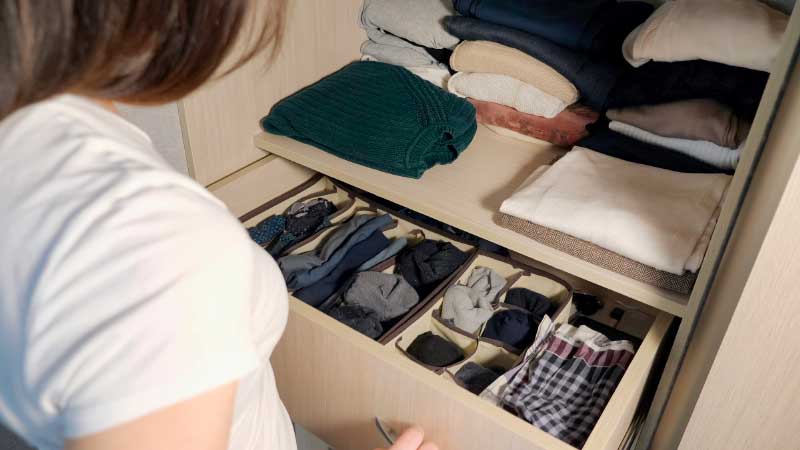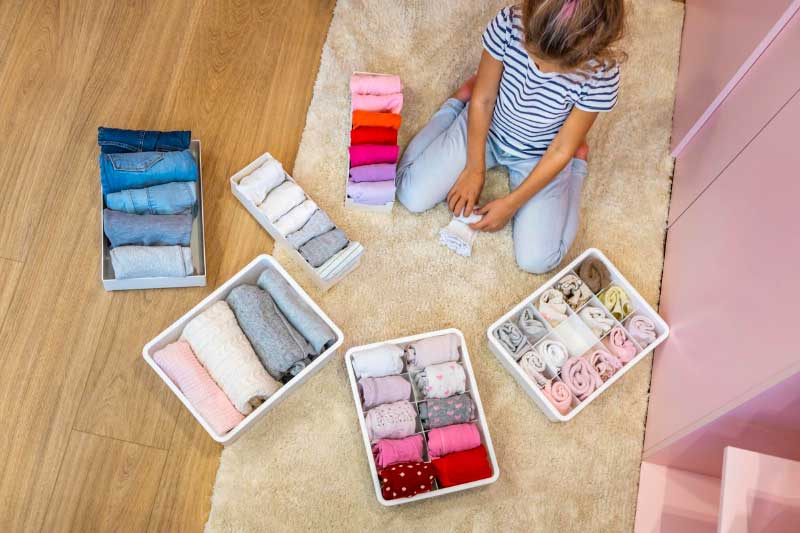
Your clothes are a collection, and like any collection, deserve to be displayed beautifully. When you can properly see all of your clothes hung up, folded nicely, and within easy view, you are also able to put together better outfits in less time. Forget only wearing a portion of your wardrobe. Instead, wear it all more often and with more creativity to boot. All of that can be achieved when your clothes have a proper place, both when they’re being actively used and also when they’re in storage.
Properly displaying and storing your clothes does require a strategy. A strategy of which can be achieved by following this guide.
Upgrade Your Wardrobe
The first step is to upgrade your wardrobe. If you have a closet but it doesn’t yet have custom shelving to maximize the space that you have, then it’s time to invest. Adding shelves inside your closet, or creating a built-in wardrobe against one wall of your room, can immediately give you so much more in terms of space and possibility. You may find yourself benefitting from ripping out the old closet and replacing it with an entirely new design that is more fit for purpose and matches your overall aesthetic. Made to measure wardrobes are the way to go to get the utmost out of your home and your wardrobe, so consider investing in this. You can add more storage space or maximize what you have. To get the most out of your investment, make sure your design has these key features:
· Maximize Vertical Space
The key benefit of any bespoke system is the ability to maximize wasted vertical space. While you can pack boxes underneath your clothes, you won’t get the same effect without a custom solution. When designing your closet, add two different levels of hanging space. This way, you can hang full-length items, like dresses, and shorter items, like blouses, neatly without wasting space.
· Use Multiple Nooks And Crannies
When it comes to adding storage space to your home, take advantage of all the nooks and crannies. If you have a room with an awkward design, for example, you can split your closet into separate sections to take advantage of the otherwise dead space in your room.
· Add Dividers to Drawers
Add dividers to your drawers to further keep things neat and tidy. This is particularly great for things like your undergarment drawer, so you can easily sort underwear, bras, socks, and so on without things getting lost along the way.
· Don’t Forget the Full-Length Mirror
When it comes to dressing, you will want space to get dressed and a full-length mirror. Unless you have a standing mirror or space to put a full-length mirror on the wall, you’ll want to add this mirror either to the inside or the outside of your closet. This will make it easy and pain-free to get dressed before heading out.
How to Properly Display Your Clothes

Once you have a beautifully bespoke wardrobe for your room, it’s time to start filling it.
· Rotate Closet By Season
Even with a bespoke closet, the last thing you want is to clutter everything up. To avoid doing this, separate your clothes into three seasons, at minimum. These seasons should be: “All Season”, “Warm Season” and “Cold Season”. If your closet of clothes is particularly large, you can then divide it into five, with an all-season collection, spring, summer, autumn, and winter.
Breaking up your clothes into seasons like this is a great way to wear more of all of your clothes and keep things feeling fresh. If you have clothes per season, then you have a whole new set of looks to look forward to every quarter. It’s a great way to dress more mindfully and take advantage of your existing clothes.
· How to Display Your Clothes for Maximum Effect
Once you’ve sorted through your clothes, it’s time to put back what’s left for this season and all seasons. You’ll want to hang up anything that would wrinkle easily or is long. In general, this means delicate blouses, trousers, and dresses.
Things like jeans, knitted garments, and cotton shirts won’t wrinkle nearly as easily, making them great options to be folded on shelves. Try to put the items you’d wear out in open display, either hanging or on an open shelf, and items you wear at home or underneath your clothes in the drawers. This makes dressing for work or going out so much easier.
· Sort Clothes By Type
To make things as easy as pie, organize your clothes into types. Put all dresses together in one section, all of your knitwear in another, jeans somewhere else, and so on. This will make it very easy to mix and match items and, most importantly, makes it easier to find items. As a result, you’ll be able to dress better in less time.
How to Properly Store Your Clothes

As for the clothes that aren’t in season, it’s critical that you properly care for them. Clothes can get musty, moldy, or moth-bitten if they aren’t properly stored. To help you learn just how to store such items properly, use these tips:
· Clean Your Clothes and Make Sure They’re Dry
The first step is to clean your clothes and make sure they’re 100% dry before you store them. This includes ironing them so that they’re mostly in the right shape. This will help clothes retain their proper shape during storage and, most importantly, prevent mold and mildew from affecting your clothes while they’re in storage.
· Types of Containers Perfect For Storing Clothes
Any container that seals tight against things like moths is a good option to store your clothes. If you’re tight on space, you may want to choose a vacuum-seal option. In this option, you put your clothes in a plastic bag and use a vacuum to suck all the air out. This compresses clothes, making them easy to store. Note this should only be used for simple garments that don’t have complicated shapes. If, for example, you have a statement blouse that has 3D sleeves, you’ll want to store that item in a box that doesn’t put pressure on the sleeves design.
· Add Some Anti-Moth Packets
Storing your clothes in a cedar closet or adding anti-moth packets can help deter those hole-eating pests. These packets are easy to add to your storage and also in your closet around the top hook of your hangers and between knitted items.
· Use Silicone Packets
Humidity could mean moisture build-up even if your clothes were perfectly dry when you initially stored them. That’s why you should add packets of silicone to your storage boxes. These packets work to absorb any excess moisture in the storage unit to keep your clothes properly dry while they’re out of sight. This will minimize the risk of your clothes smelling musty or dry rotting while in storage.
· Rotate and Air Out Clothes Regularly
So long as you change out your clothes for each season, you should be airing everything out well enough without any extra effort on your part. If you have items you’ve put away in deep storage, for example, a wedding dress or even ski clothes, you’ll want to air these out every once in a while to prevent any issues in the long run like mold.



